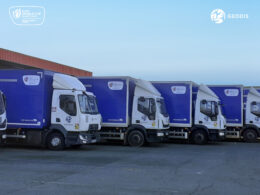 Once again, for this month’s blog, Pól Sweeney is joined by guest contributor, Chris Jones, EVP Marketing & Services, Descartes Systems Group with some thoughts on how organisations can harness the data gathered through mobile technology to get a true view of what is happening in the field.
Once again, for this month’s blog, Pól Sweeney is joined by guest contributor, Chris Jones, EVP Marketing & Services, Descartes Systems Group with some thoughts on how organisations can harness the data gathered through mobile technology to get a true view of what is happening in the field.
GPS-enabled mobile technology can be extremely beneficial to your businesses- understanding what your resources are doing and using that information to recalibrate your planning processes and management strategies.
Unless you are tracking your field resources with GPS-based activity statuses, you may have an inaccurate picture of what they are really doing. Field workers are largely unsupervised and, unfortunately, there may be a few ‘bad apples’ in some organisations who aren’t entirely honest about reporting their activities. ‘Stretching’ is particularly prevalent, with hours worked and/or miles driven rounded up in an overly optimistic manner. If you want to know where you are losing 2-3% of your productivity, it could be right there. On the other side of the coin, without accurate tracking, it can be difficult to identify and reward high performers among those largely unsupervised field workers.
Which brings me to the second point – mobile data is big data. Every GPS ping tells a story; one that you wouldn’t get from doing the monthly ride with one of your field resources. A lot of mobile data is transactional (pickup, delivery, arrived, depart, etc.), but provides a wealth of operational performance information because GPS provides time and location context. ‘Slicing and dicing’ that information over a period of time can paint the true picture of good and bad performance and allow you to break down field performance into its fundamental components. If that doesn’t sound like a job for big data, I don’t know what does.
Getting the fundamental view of what is happening in the field provides a tremendous opportunity to improve the planning processes, management strategies, and human resource policies. Planning without operational data is an open loop process that runs off too many assumptions.
While the natural inclination is to capture as much data as possible, consistency is more important than breadth of data collected. It isn’t realistic to expect field resources to get it right every time without workflow management and automation. However, making the workflow convoluted to capture all possible cases makes field workers unproductive and requires a lot of support.
There are two key takeaways here. First, if you aren’t using GPS-enabled mobile devices with your field resources your company is experiencing higher costs and inconsistent customer service – you just don’t know it. Second, all that transactional data you are collecting as part of your mobile strategy to go paperless or simply track your resources can be turned into a tremendously powerful continuous improvement programme.












